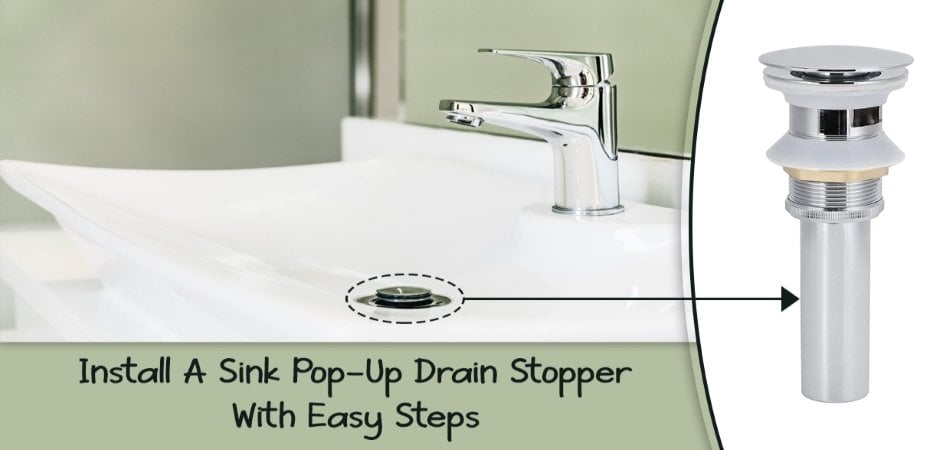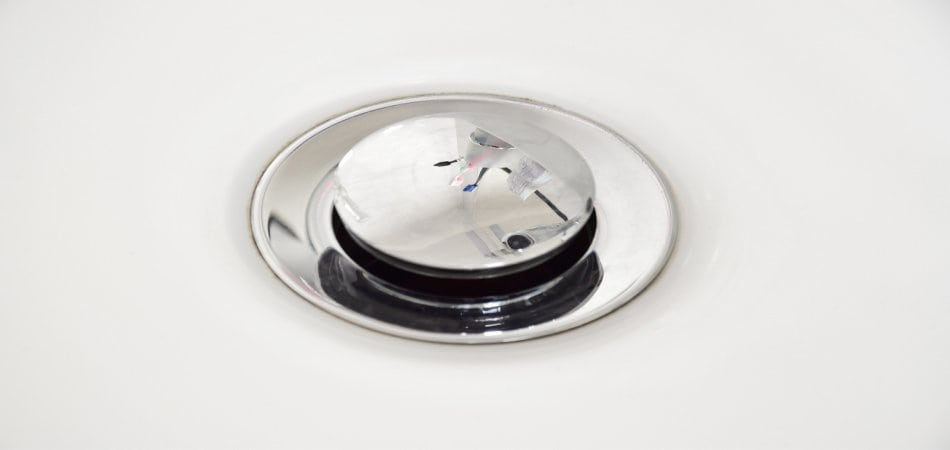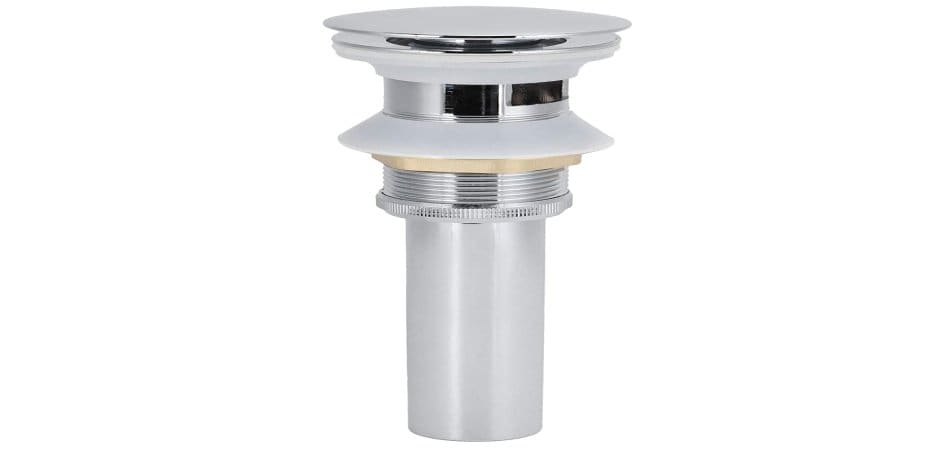A pop-up drain stopper for a bathtub or sink is a standard mechanical device in a regular toilet. Its primary purpose is to seal the sink or bathtub, stopping the water from draining. This process requires a system of links and levers that move the drain stopper vertically. It’s easy to fix the pop-up drain stopper, but it looks complicated. You should know how to fix it if it isn’t functioning as intended.
Working Mechanism of a Pop-Up Stopper
These stoppers are simple devices that work perfectly when a link and lever system works effectively. The system helps the drain stopper move up and down, which facilitates sealing the sinks or bathtubs or unsealing them to allow water to pass through easily.

The pop-ups or regular stoppers of the bathroom sink, with the help of a lever or knob, are raised or lowered. These are typically located near or on the body of the faucet. The lever or the knob of the pop-up drain stopper is usually connected to the lift rod. This lift rod is now fastened with a “clevis,” a typical slotted flat bar.
With the help of a small spring clip, the flat, slotted clevis is connected to a pivot rod. A ball assembly- through a rubber pivot ball, a rod is passed, and the stopper tailpiece slopes slightly upward. The pivot rod pushes the stopper vertically under the sink in the drain body to work.
The lever operates a lift linkage, pulling the spring. The spring then pulls the rocker arm, raising or lowering a stopper.
The pivot rod pushes the stopper upward when the lift rod and knob pushes downward.
If someone wants to remove the pop-up drain assembly, they may need help. Removing the retaining nut on the bathroom sink is sometimes necessary, and then the rod must be extracted and pivoted. In this setup, the stopper is twisted to disengage it from the pivot rod. It’s straightforward to pull out the rocker arm linkage and stopper. This mechanism is associated with old-style bathtubs, which are still used today. The overflow plate is lowered or raised in these bathtubs primarily because it is still a lever.
How To Remove Drain Stopper Of A Bathtub?
If mechanical problems or blockages occur, removing the tub stopper is very simple. There are different bathtub drain stopper types: some are old-style mechanisms, and some are newer, loaded with springs.

Here is the simple method of how to remove the bathtub drain stopper of old-style tubs to make it a part of your maintenance routine.
Grip The Stopper Body:
If you want to pull out the stopper with its body, the first step is to grip it and then pull it out. The hinged rocker arm also comes along when you pull it out.
Clear The Stopper:
When you have pulled the stopper out, you need to clean it and remove any hair, gunk, or debris.
Check The Rubber Seal:
In the third step, check the rubber seal. If it is damaged, replace it by removing the old seal first.
Reinstall The Stopper:
In the last step, reinstall the rocker arm and stopper. After that, ensure the flange is in good shape and tightly seated. (The old tub flanges may be corroded.)
Fixing A Bathtub Pop-Up Drain Stopper Properly

Here is a short explanation of the Bathtub drain stopper and how to fix a pop-up drain stopper.
Remove The Attached Screw:
First of all, you need to remove the overflow cover plate, which in this case fastened to the screws. So first, you need to remove these screws.
Pull The Plate and Lever:
In this step, you will partially remove the lever and plate mechanism but pull it from the overflow hole.
Adjusting The Nut:
After that, adjust the nut at the place of linkage. Shorten it to let it down or lengthen it to raise the stopper.
Push The Assembly Back:
When the nut is completely adjusted, replace the cover plate by pushing the assembly back.
Lift Out The Stopper:
Finally, lift out the rocker linkage and stopper. Check the seal properly, clean all the debris and hair, and push it back into the drain.
Now that you have stopped maintenance over, below is an explanation in a more nuanced way:
There are some common problems with the Tub drain stopper; sometimes, the pop-up stopper does not fully close, the drain does not fully tighten the flange, or it easily opens when the knob or lever is engaged. When the stopper of the tubs does not close completely, the tubs do not fill appropriately, and it causes the wasting of water. The stoppers of the tubs that do not open all the way or do not open readily cause the tub to drain sluggishly.
The bathtub pop-up has two parts: the stopper and an overflow assembly. The stopper is attached to a rocker arm extending back towards the drain. The overflow assembly, on the other hand, is nothing but a spring at the end. This mechanism will either lower or lift the rod with its help.
If you push the lever, it will flip upward, pushing the rod down. With this downward motion, the stopper rocker also moves downward, raising the stopper. When the lever flips upward, it also controls the rod to move up, allowing the drain to allow water flow and causing the stopper to drop.
The pop-up type allows for the adjustment of the stopper striker length by adjusting the rocker’s arm or the stopper seats.
To Adjust The Overflow Assembly:

Firstly, remove the screw. This screw is used to secure the cover plate overflow. You need to pull this lever and plate assembly from the overflow hole. Remember that this mechanism should only be removed partially and not entirely. Now, you can adjust the length of the rod assembly by adjusting the nut. To increase the stopper’s length, raise it or decrease it to shorten it. Once you have adjusted the stopper’s length, push back the assembly so you can change or replace the top cover plate.
To Adjust the Stopper:
If you want to adjust the stopper or replace the bathtub drain stopper, you need to lift out the rocker arm, which you can do by lifting the stopper, as they are both attached.
Lifting out the drain will allow you to check the integrity of the rubber seal. If necessary, replace it. Then, clean it and remove the hairs and debris. Then, adjust the nut on the underside. After doing this, the connection with the rocker’s arm will be lengthened or shortened. It would help if you made sure that the flange is sealed tightly. To do that, take the stopper and arm into the drain hole.
One of the best ways to make the stopper work properly is to clean the drain and remove the shampoo and soap residue from debris and hair.
Fixing A Sink Pop-Up Drain Stopper
There are many reasons why the water around the Bathroom sink drain stopper may leak or be blocked. Fixing the sink pop-up is easy if it doesn’t sit properly. The fix is simple for uneven pop-ups; everyone can easily adjust it. All you need to do is change a few parts.
Sometimes, the main reason for these problems is hairs stuck around the stopper base or in the pivot rod mechanism. Another reason is that the clevis may be out of adjustment.
The knob here works like a lever in a similar scenario as explained above. Here, you push the knob, which elevates the stopper with the help of the pivot rod. Similarly, as you pull on the knob, now your stopper moves downward and closes the drain as the pivot rod is pulling the stopper.
If the sink drain stopper is not high enough or too high in the drain, then it’s necessary to go under the sink and, with the help of a flashlight, identify all the parts.
It would be best if you pinched the spring clip from the pivot rod to release the flat bar. Then, move the rod into a different hole up or down in the clevis, and the spring clip is easily replaced.
Hair and crud get stuck in sink drains, clogging the drain. To clean the stoppers, you need to extract the crud and hair. In some sinks, it’s very easy to disengage the stopper and pull it out. You need to go under the sink and work there to pull it out. You need to turn the stopper counterclockwise by removing the pivot rod.
Here are some steps to remove the drain stopper from the sink.
Removing A Stuck Pop-Up Drain Stopper
Lift the stopper out with a slight twist. If it isn’t easily pulled, you need to work below the sink, as the stopper is linked to the mechanism under the sink. You need to unscrew the pivot rod and disengage it from the nut by pulling it out. If you need to loosen it, use locking-jaw pliers.
Maintenance And Replacement Of Pop-Up Drain Stopper
Cleaning the stopper from debris and hair usually does the trick of fixing the stopper drainage issue. You can clean it by lifting the stopper from the drain. If the stopper or its seals are damaged, they must be replaced.
Installing A Pop-Up Drain Stopper
Drop the sink’s stopper back into the drain hole and adjust the hole at the bottom towards the pivot rod. Now, insert the pivot rod, allowing it to engage with the hole in the bottom of the stopper. Then, tighten the retaining nut with the stopper in the up position. If the drain closes, with the help of the pivot rod, slope slightly uphill to the tailpiece of the clevis.

Adjusting the Pop-Up Drain Stopper Operation
On the clevis, loosen the set screw, and in an up or down direction, adjust the strap. It will help open or close the stopper. After that, retighten the set screw.
Resetting The Pivot Rod For Pop-Up Drain Stopper Adjustment
After adjusting the clevis screw, if it seems not working, then free the pivot rod, squeeze the spring clip, and reset the pivot rod. Insert the rod by moving the clip up to the next clevis hole. It must be necessary to keep tweaking to find the right hole in the clevis,
Maintaining Pop-Up Drain Stopper for Proper Functionality
If the surface around the pivot ball leaks, tighten the retaining nut, which helps the ball stay in place. Sometimes, we must change the washer or gasket in the rod assembly and pivot ball.
The best working order for the stopper is that it is clean of all dirt and other stuff like shampoo and soap residue or hair.
Conclusion
There are many different steps to fixing a sink and bathtub pop-up stopper. Anyone can quickly fix it, and it’s also very simple if there is a need to change it. The main thing is cleaning the mechanism and adjusting the nut clevis so the stopper works appropriately.
If any part is damaged, replace it and reinstall everything securely. There are different Bathtub drain stopper types; therefore, according to their type, fix it. Regular cleaning is vital to keeping it working correctly.
You can contact sanitary fittings and bathroom accessories manufacturers at Hofensanitary with any difficulty.

